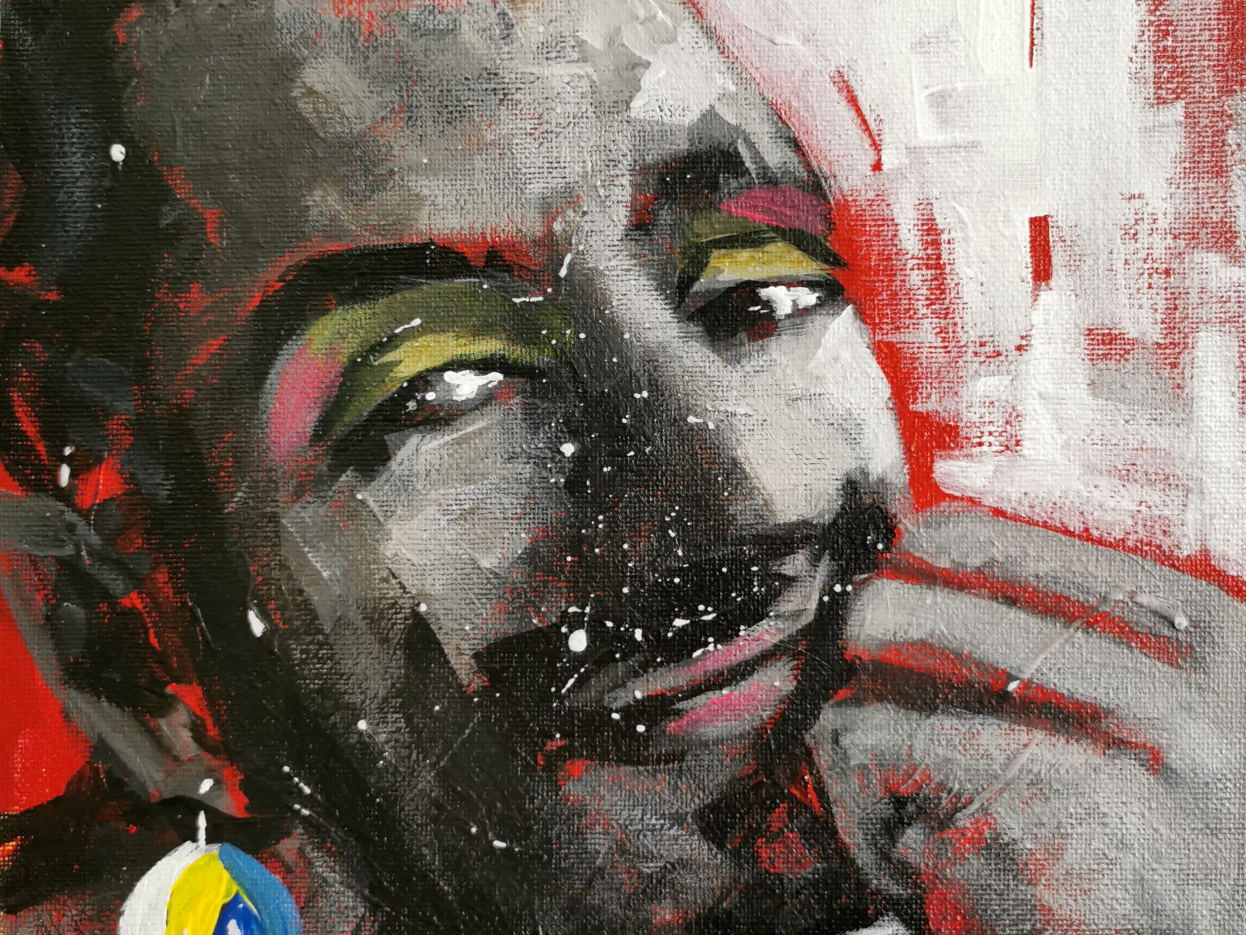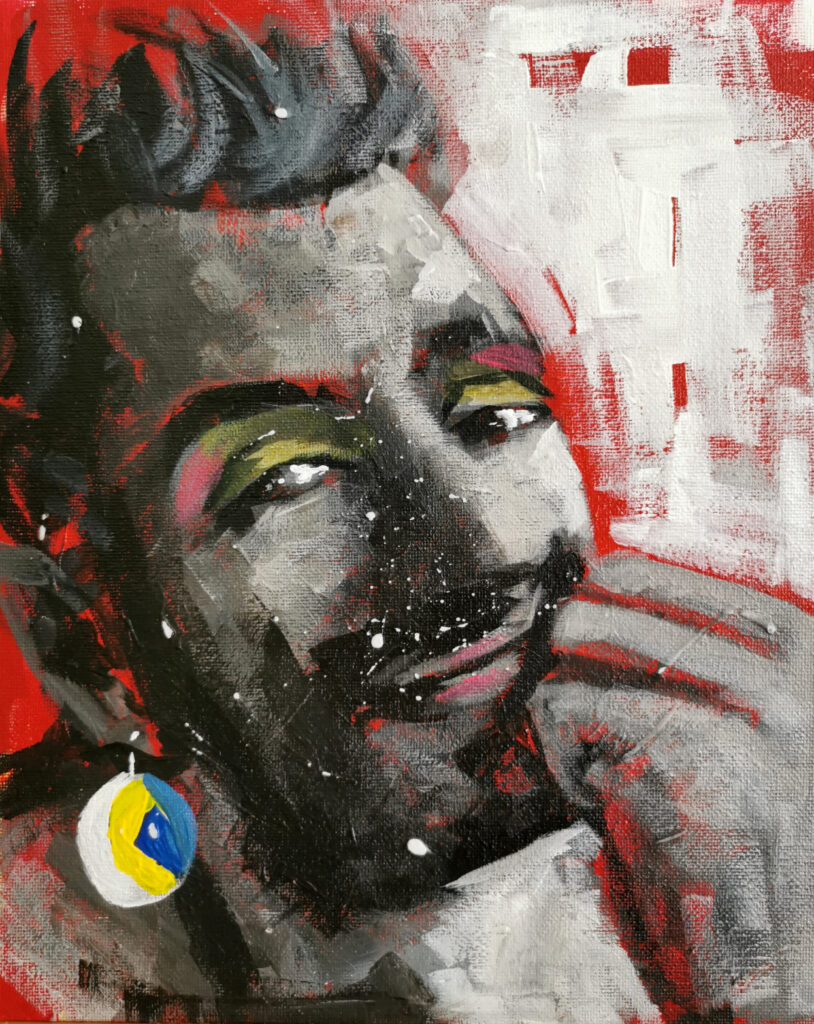Texts by Hassan Zahirović
Slikar Selman već dugi niz godina vodi borbu za svojim identima. Sam kaže da je to borba za ljubav i priznanje ili borba u kojoj se mora boriti sa sobom i sa drugima. Selmam je dugo skrivao jedan dio svoje ličnosti i skoro u tridesetoj godini se odlučuje za iskorak gdje javno oznamuje svoj identitet homoseksualnog muškarca. Opet iskorak u slobodu. Opet borba sa predrasudama. Opet želja da bude prihvaćen. Ponovo i ponovo. Ovaj puta ne samo berlinska, ali prije svega balkanska, bosanska, romska.
Sam vjeruje da umjetnost pomaže da bolje razumijemo sebe i promijenimo način na koji nas drugi gledaju.
Selman je jedan od rijetkih bosanskohercegovačkih slikara koji se udaljuje od tradicionalnog oblikovanja i od klasičnog portretisanja. Mnogi njegovi portreti zasigurno zauzimaju posebno mjesto u historiji ne samo bosanskohercegovačke umjetnosti. Najčešće su prepoznatljivi po čistom i na drugu stranu i specifičnom koloru, ali ponekad i ne. Ljubav prema „čištoj“ šarenoj boji i izražaju je Selmanova jača strana jer vrlo vješto poukazuje da se da raditi sa svim bojama, nijansama i da su kombinacije boja zapravo čisti emotivni doživljaj i melodiju koju slikar trenutno nosi i iznosi. Sa pravom tvrdimo da se slikar usavršio tehnikom slikanja autoportreta. Neko može tvrditi da je Selman pomalo narcisoidan pa se slikao kako bi još više učvrstio svoju slavu. To je stara poznata priča koja je vezana i za voljenog Rembrandta. Selmanovi autoportreti su mnogobrojni i raznovrsni i ne nalikuju na sebe. Kad počinje sa onima, koji su sve više introspektivni i sirovi, Selman se naglo otrgne i donosi seriju veselih portreta koji su često povezani sa njegovim identitom homoseksualca. Selmam se cijelu deceniju kroz svoje autoportrete prikazuje u svakojakim izdanjima. Vidimo na njima skalu emocija, od onih jednostavnih do komplikovanijih. Od krajnje sreće pa sve do tuge i bijesa. Momak sa bosanskom naušnicom je potpuno novi slikarski selfi, gdje na jednu stranu Selam ponosno iskazuje svojih nekoliko identita, romski, bosanski, krajiški, homoseksulani, umjetnički, a ujedno pruža ispričanu priču bez grča, bez agresivnosti, krika, nudi olakšanje sebi i posmatračima.
MOMAK SA BOSANSKOM NAUŠNICOM
THE BOY WITH THE BOSNIAN EARRINGS
Painter Selman has been fighting for his identities for many years. He says it is a struggle for love and recognition or a struggle in which he must fight with himself and with others. Selmam has been hiding a part of his personality for a long time and almost in his thirties he decides to take a step where he publicly marks his identity as a homosexual man. Step into freedom again. Again a struggle with prejudice. Again the desire to be accepted. Again and again. This time not only Berlin, but above all Balkan, Bosnian, Roma.
He believes that art helps us better understand ourselves and change the way others look at us.
Selman is one of the few Bosnian painters who is moving away from traditional design and classical portraiture. Many of his portraits certainly occupy a special place in the history of not only Bosnian art. They are usually recognizable by their pure color and specific color, but sometimes not. The love for “pure” colorful color and expression is Selman's strong point because he very skilfully shows that you can work with all colors, shades and that color combinations are actually a pure emotional experience and melody that the painter is currently wearing and expressing. We rightly claim that the painter perfected the technique of painting self-portraits. One can argue that Selman is a bit narcissistic so he took pictures to further solidify his fame. It is an old famous story that is also related to the beloved Rembrandt. Selman’s self-portraits are numerous and varied and do not resemble themselves. When he starts with those who are increasingly introspective and raw, Selman abruptly breaks away and brings a series of cheerful portraits that are often associated with his homosexual identity. Selmam has been portrayed in all sorts of editions throughout his decade through his self-portraits. We see on them a scale of emotions, from the simplest to the more complicated. From extreme happiness to sadness and anger. The guy with the Bosnian earring is a completely new painting selfie, where on one side Selam proudly expresses his several identities, Roma, Bosnian, Krajina, homosexual, artistic, and at the same time provides a story without cramps, without aggression, screams, offers relief to himself and viewers.
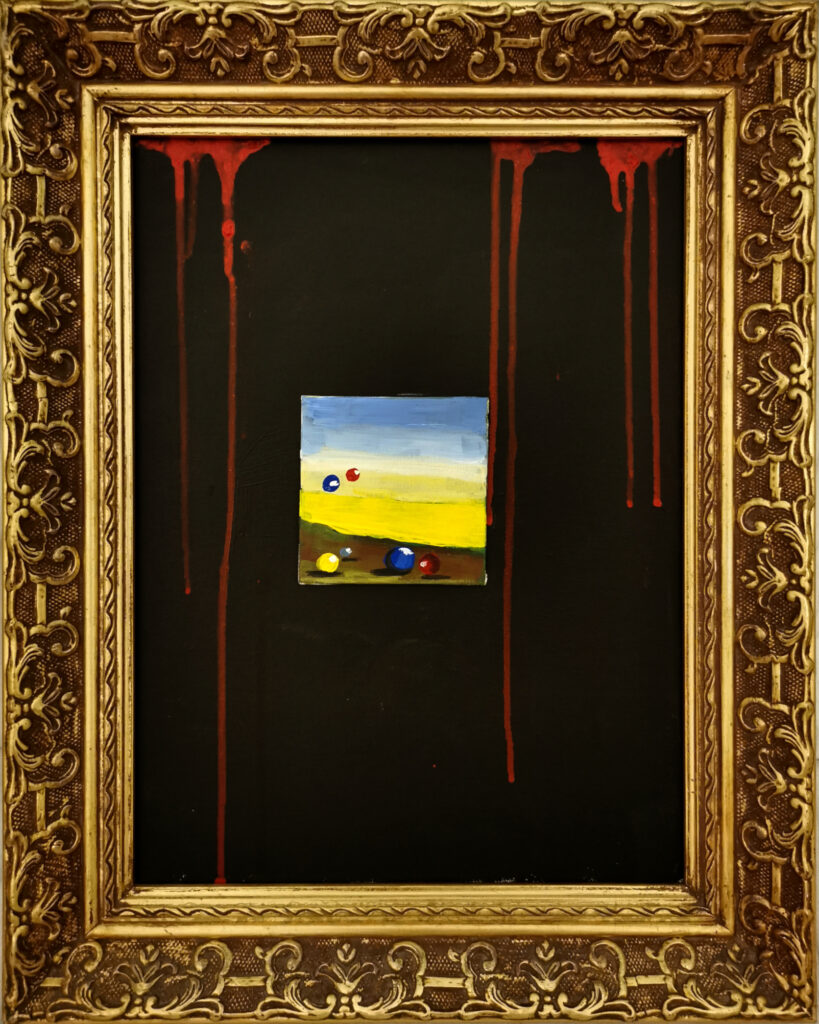
SA MOG PROZORA (Djetinjstvo I)
Romska djeca se podižu i odgajaju u drugačijim okolnostima nego većinsko stanovištvo. Tu i nastaje problem. Romska djeca su okružena tradicionalnom porodicom. Edukacijski a odgojni metod je životni. Nikoli podučavanjem, ali učit se od odraslih, kako oni funkcionišu, misle i rade. Učenje iz primjera uključuje proces promatranja, oponašanja i, kasnije, sudjelovanja.
Kod Selmana je uvijek neobično vidjeti sliku koja ne prikazuje portret čovjeka. To su njegovi unikati kojima uvijek dolazi iz skrivene unutrašnje potrebe, nečega što iskonski nosi sa sobom, što ga tišti i od čega se konačno želi da izliječi. U njima je isto suptilan i autentičan, ali ne i katarzičan. Ostavlja nas zamišljene i u redu za čekanje gdje se pričaju nastavci priča. Zbog ovih pomaka ne ostaje izvan glavnih struja najprije visokomodernističkoga umjetničkog okružja, postiže poziciju izdvojenog i prepoznatljivog, ali istodobno i izolirane pojave. Slika prikazuje dječju percepciju svijeta i surovu stvranost koja je često i krvava. Djeci se često niječe očitost problema ili im se zatajuje što se događa u trenutku kad je djetetu roditelj najviše potreban. Neizvjesnost i strah. Selman dijeli vrlo tragičnu i duboku priču dječjeg bježanja u svijet fantazije gdje je sve šareno, puno balona za igru, bez prijatelja, saharski prizor lebdeće duše Malog princa kojem je prije nekoliko trenutaka Zmija oduzela život. Ali duša malog čovječuljka je sretna jer se opet vraća na svoju planetu, kući, u svoju sigurnost.
FROM MY WINDOW (Childhood II)
Roma children are raised and raised in different circumstances than the majority population. That's where the problem arises. Roma children are surrounded by a traditional family. The educational method is vital. Never by teaching, but learning from adults, how they function, think and work. Learning from examples involves a process of observation, imitation, and, later, participation.
With Selman, it is always unusual to see a picture that does not show a portrait of a man. These are his uniques that always come from a hidden inner need, something that originally carries with it, that oppresses him and from which he finally wants to be cured. In them he is equally subtle and authentic, but not cathartic. It leaves us thoughtful and in line to wait for the sequels to be told. Due to these shifts, he does not stay outside the main currents of the highly modernist artistic environment, he achieves the position of a separate and recognizable, but at the same time isolated phenomenon. The painting depicts a child’s perception of the world and a harsh reality that is often bloody. Children are often denied the obviousness of the problem or denied what happens when a child needs a parent the most. Uncertainty and fear. Selman shares a very tragic and profound story of a child escaping into a fantasy world where everything is colorful, full of balloons to play with, no friends, the Saharan scene of the floating soul of the Little Prince whose life was taken away by the Snake a few moments ago. But the little man's soul is happy because he is returning to his planet, home, to his safety.
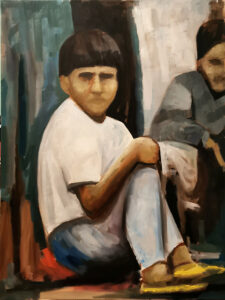
TJESKOBA (Djetinjstvo II)
Mahala Ružica u Bihaću. Mersuda su tamo rodili još davne 1986. godine. Mahala djetinjstva. Sretnog, ali nimalo jednostavnog. Djetinjstva, gdje su djeca stvari ili nečije igračke. Romska zajednica. Romska mahala. Romska porodica. Romski komšiluk. Sa osmanaest godina si već star. Šutnja je mjesto na kojem sve počinje. Rodno mjesto, prostor na kojem se odrasta bez riječi. Nijemo u buci.
Selman temelji rad na konceptualnoj strogosti, slikarskom mediju tišine, straha i ankcioznosti. Ostaje sopstven svojih dugim potezima, jasnim gestima, začudnoj emociji, koje se ne boji, ne stidi se, izazivački njome prkosi, pokazuje je, pokušava da se oslobodi sopstvene krize neproživljenog djetinjstva i sveukupno mobilizira stvaralačku energiju. Dječaka smiješta u njegov kut u kojem isto ne može da ima smiraj jer je dijete, neželjeno romsko, nepoželjno za svijet. I žute papuče nisu toliko izražajne da ne povrijede. Oči su se izdubile, dosljedne svome obliku, karakternosti i slojevitosti preživljenih i doživljenih impulsa iz stvarnosti. Priče su po ko zna koji puta ispričane i uvijek su mračne, teške i bolestive. Dijagram jedne intimne ispovijesti. Krik u javnosti. Neverbalna drama. Unustrašnja i vanjska. Šutnja bez podkonteksta. Grč neprevaziđeni.
ANXIETY (Childhood II)
Mahala Ružica in Bihać. Mersuda was born there back in 1986. Mahala childhood. Happy, but not at all simple. Childhood, where children are things or someone’s toys. Roma community. Roma neighborhood. Roma family. Roma neighborhood. You are already eighteen years old. Silence is where it all begins. A place of birth, a place where one grows up without words. We are not in noise.
Selman bases his work on conceptual rigor, a painterly medium of silence, fear, and anxiety. He remains his own with his long strokes, clear gestures, strange emotion, which he is not afraid of, is not ashamed of, defiantly defies it, shows it, tries to get rid of his own crisis of unexperienced childhood and mobilizes creative energy overall. He places the boy in his corner where he also cannot have peace because the child, unwanted Roma, is undesirable for the world. And yellow slippers aren’t so expressive as not to hurt. The eyes are hollowed out, consistent with their shape, the character and layering of the surviving and experienced impulses from reality. The stories are told many times and are always dark, difficult and painful. A diagram of an intimate confession. A shout in public. Nonverbal drama. Internal and external. Silence without subtext. Cramps unsurpassed.
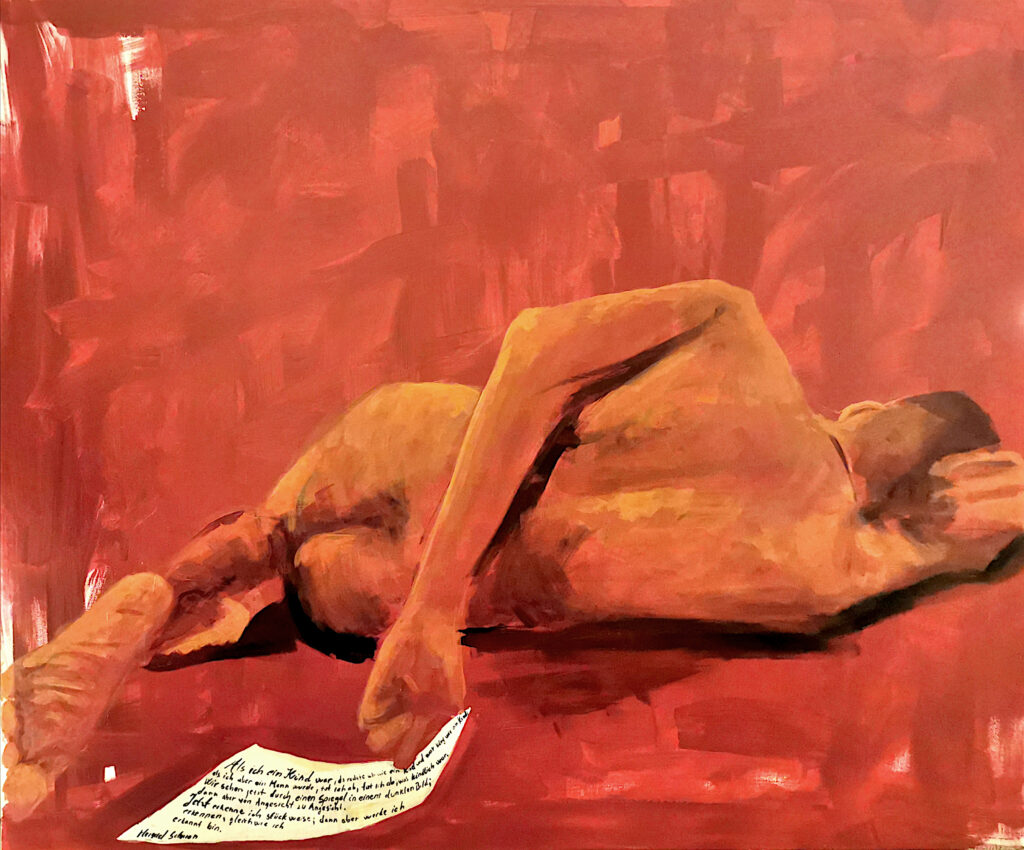
CRVENA SOBA TUGE (Djetinjstvo III)
Adolescencija je kod većina ljudi zahtjevna jer mnogi mladi ne uspijevaju uspostaviti ravnotežu između strahova koji su uobičajeni ili ne za ovo razdoblje. Sticanje dobrih prijateljstava, uspjeh u školi, neke druge aktivnosti i razvoj snažnog osjećaja vlastitog identiteta. Povremena loša raspoloženja i burne emocionalne reakcije su normalni dio adolescencije, samo je problem ukoliko dođe do depresije. Romi su u tom komplikovaniji jer predrasude su sveprisutne. Često ih opisuju kao osobe kojima ne treba vjerovati i koje se ne žele uklopiti u društvo. Kako živjeti u društvu gdje se na svakom koraku pokazuje da se Romima ne vjeruje. Integracija je i više nego zahtjevna jer se obično od Roma traži gubitak romske kulture. Čak obrazovani Romi koji cijeli život žive unutar većinskog stanovništva često nailaze na isključivanje. Strah od neuklapanja i odbacivanja ponekad je toliko prisutan da neki Romi moraju prikrivati svoje etničko porijetlo kako bi i dalje lakše da žive u društvu, nego da budu dio njegovo ruba.
Zanimljivi svjetlocrveni akt u nijansama crvene nije jedina slika nastala iz želje dokazivanja i igranja jednom osnovom. Crni akti i torza iz praškog perioda koja je autor slikao na Žižkovu u Pragu iz 2016. godine nose zasigurnu istu misaonu tehniku ali drugačije rezultate. Boja je svedena na minimum – slikar se igra različitim tonovima isključivo jedne boje – crvene, koja u isto vrijeme i spaja i razdvaja prostor zajedno sa horizontalnim i vertikalnim linijama. Skrhano ležeće tijelo i možda posljednje pismo u ruci slkar smještava u nježne horizontalne pomake kistom, dok dubinu crvene sobe, unutrašnjeg zatvora, izdužuje i produbljuje još više vertikalnim debelim potezima da su čak naglašene i rešetke ili ograda iza koje se dalje ne može. Slikar opet uspijeva da emotivno ostane na rubu propasti. Drži posmatrača i nudi mu opet otvoren prostor. Slikar se poigrava konturom i linijom, u ovom slučaju naglašavajući je još jače, da naglasi samu tjelesnost tijela i unutrašnje boli. Zaključujemo da slikar u poznije vrijeme stvaralaštva sve više i više reducira liniju i konturu čineći je svjetlijom, neprimjetnijom i diskretnijom. Selmanova platna nisu nikada ukrašena viškom ornamenata niti skupocjenim galerijskim okvirima, ali sigurno jesu istinskom slikarskom intuicijom i stvaralačkom senzacijom koja dolazi iz dubine duše. Selmana nikada nije zanimala puka reprezentacija stvarnosti, njegove mrtve prirode su rijekte, skoro da i ne postoje ukoliko ne računamo one iz studentskih dana (izuzetak je Pogled na Toskaniju, Prag, 2016.). Stvara potpuno novi – njegov vlastiti svijet okrunjen subjektivnošću, te je samim tim empatijski povezan sa svakom linijom i konturom u svojim djelima. U Selmanovim platnima se, i lako i teško, ulazi u slikarev svijet i prati se svaka linija i svaki potez kista kroz koje posmatrač prati slikareve misli. Slikar ne želi da pokaže tradicionalno slikarstvo, koje po njegovom mišljenju je passé, nestinito. Selman teži avantgardnom predstavljaju slikarskog ne samo skromnog romskog ili i svakojakog drugog umjetničkog svijeta i života.
RED ROOM OF SORROW (Childhood III)
Adolescence is demanding in most people because many young people fail to strike a balance between fears that are common or not for this period. Gaining good friendships, success in school, some other activities and developing a strong sense of self-identity. Occasional bad moods and violent emotional reactions are a normal part of adolescence, only a problem if depression occurs. The Roma are more complicated because prejudices are ubiquitous. They are often described as people who should not be trusted and who do not want to fit into society. How to live in a society where it is shown at every step that the Roma are not trusted. Integration is also more than demanding because Roma are usually required to lose Roma culture. Even educated Roma who live their entire lives within the majority population often encounter exclusion. The fear of non-alignment and rejection is sometimes so present that some Roma have to conceal their ethnic origin in order to continue living more easily in society than to be part of its fringe.
An interesting light red nude in shades of red is not the only image created from the desire to prove and play with one basis. The black nudes and torsos from the Prague period that the author painted on Žižkova in Prague in 2016 certainly carry the same thought technique but different results. The color is reduced to a minimum – the painter plays with different tones of only one color – red, which at the same time connects and separates the space together with the horizontal and vertical lines. The painter places the broken body and perhaps the last letter in his hand in gentle horizontal movements with a brush, while the depth of the red room, the inner prison, lengthens and deepens even more with vertical thick strokes that even the bars or fence behind which one cannot go further are accentuated. The painter again manages to stay emotionally on the verge of collapse. It holds the observer and offers him open space again. The painter plays with contour and line, in this case emphasizing it even more strongly, to emphasize the very physicality of the body and the inner pain. We conclude that the painter in the later period of his work more and more reduces the line and contour, making it brighter, less noticeable and more discreet. Selman’s canvases are never adorned with excess ornaments or expensive gallery frames, but they certainly are a true painterly intuition and creative sensation that comes from the depths of the soul. Selman has never been interested in a mere representation of reality, his still lifes are rare, almost non-existent if we do not count those from his student days (the exception is View of Tuscany, Prague, 2016). He creates a completely new one – his own world crowned with subjectivity, and is therefore empathetically connected to every line and contour in his works. In Selman's canvases, both easily and with difficulty, one enters the painter's world and follows every line and every stroke of the brush through which the observer follows the painter's thoughts. The painter does not want to show traditional painting, which in his opinion is passé, untrue. Selman strives for the avant-garde to represent the painter's not only modest Roma or any other artistic world and life.
Machos
Merso i Ferdi. Dvojica od petoro braće Selman. Bišćani. Romi. Veseli, pričljivi, talentovani, vrijedni. Različitih godina mada blizanci po školi koju su zajedno završili, od osnovne, preko srednje, do visoke. Počeli su skromno – mijenjali slike za hranu, sami finansirali školovanje, upisali akademiju likovnih umjetnosti… Intrigantni na svoj način šarmiraju i osvajaju oko sebe. Kist ne ispuštaju iz ruke. Čak ga koriste i po petnaest sati dnevno. Iz skromne kuće u romskoj mahali u Bihaću pronalaze utočište na Akademija umjetnosti Univerziteta u Banjoj Luci. Bihaću i voljenoj Uni se često vraćaju. Znatiželja za novom spoznajom i prezentiranju vlastitog rada ih odvodi u svijet. Njemačka im postaje drugi dom. Donosi im ličnu i profesionalnu satisfakciju. Svoja vrata Mersudinu, Mersi, autoru ove slike, otvara Berlin, dok njegovom bratu Ferdinandu, Ferdi, Minhen. Braća skromnih početaka ne zaboravljaju na prošlost. Ona je najprisutnija u svakoj njihovoj boji, potezu, emociji. Iz nje se izdižu i jačaju kao preprodano željezo iz komšiluka. Braća Selman su jedna od najljepših pozitivnih priča koja razbija predrasude o pripadnicima romske zajednice.
Brata Ferdija i sebe u nekom duhovnom slikar Selman smislu vidi iskreno. Mada fizički napola. Uvijek u macho stilu. Sam kaže da su slatki. Ukusno obučeni i uredno ošišani, podbrijani i počešljani. Sve blista i miriše. Stariji i ozbiljniji brat, rukom grli, pazi i čuva onog mlađeg. Opet čista i elegantna Selmanova kreacija. Borba boja stočena u crnoj. Prefinjenoj. U čijoj se igrariji slikar poigrava i sa tamnijom bojom svog i bratovog tena. Ferdu potamljuje ili sebe možda osvjetljuje. Sve je zategnuto, osim napućenih jarkih usana punih života, ljubavi i energije. Oštrice koščatih čeljusti, izduženog lica, kosih azijskih očiju i špicastih đavoljih ušiju je neobična izvedba kod Selmanovih portreta. Bježi od uobičajenoj zaobljivanja. Slikar kazuje priču početka jednog kraja. Ponosni i uzdigunti Selmanovci idu dalje. Nada nikada ne umire.
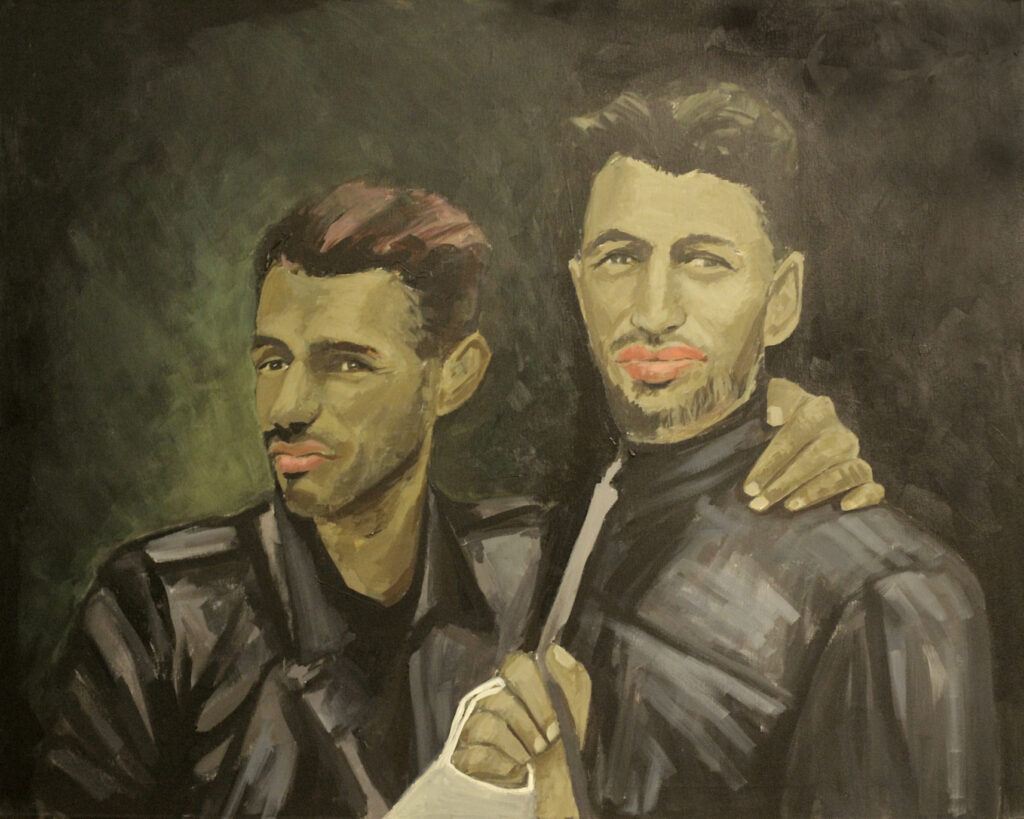
Machos
Merso and Ferdi. Two of the five Selman brothers. Biscani. Roma. Cheerful, talkative, talented, hardworking. Different years, although twins in the school they finished together, from elementary, through high school, to high school. They started modestly – changing pictures for food, financing their own education, enrolling in the Academy of Fine Arts … Intriguing in their own way, they charm and conquer around them. They do not drop the brush from their hand. They even use it for fifteen hours a day. From a modest house in a Roma neighborhood in Bihać, they find refuge at the Academy of Arts of the University of Banja Luka. They often return to Bihać and their beloved Una. Curiosity for new knowledge and presentation of their own work takes them into the world. Germany becomes their second home. It brings them personal and professional satisfaction. Berlin opens its doors to Mersudin, Mercy, the author of this painting, while to his brother Ferdinand, Ferdi, Munich. Brothers of humble beginnings do not forget the past. She is most present in their every color, move, emotion. From it they rise and strengthen like resold iron from the neighborhood. The Selman brothers are one of the most beautiful positive stories that shatters prejudices about members of the Roma community.
Selman sees his brother Ferdi and himself in a spiritual sense sincerely. Although physically half. Always in macho style. Sam says they are cute. Tastefully dressed and neatly cut, shaved and combed. Everything shines and smells. The older and more serious brother hugs, watches over and takes care of the younger one. Clean and elegant Selman creation again. Fighting colors stocked in black. Sophisticated. In whose play, the painter also plays with the darker color of his and his brother's complexion. Ferdu darkens or perhaps brightens himself. Everything is taut, except for full bright lips full of life, love and energy. The blades of bony jaws, elongated face, oblique Asian eyes and pointed devil ears are an unusual performance in Selman's portraits. Run away from the usual rounding. The painter tells the story of the beginning of one end. Proud and exalted Selmans go further. Hope never dies.
PRIDE EVENING
Rijetka Selmanova slika u kojoj iza centralne figure vidimo javni prostor. Linearnu kompoziciju sačinjavaju široke linije koje nastaju na oštrom razgraničenju između dva tonaliteta i to sa figurom tijela koje je ograničeno linijama i razlikama u svjetlosti i igrom linija koje označavaju prostor. Linije imaju različite učinke na osnovu svog mjesta, smijera i namjene. Ponavljanje istih ili sličnih elemenata i oblika, tonova ili boja u određenim varijantama označava osebujan ritam slike. Atmosfera jednog izlaska je u punom jeku. Ne samo da je slikar unešen i u procesu spoznaje ili zadovoljavanja svoje znatiželje, nego prije svega grad priča svoju priču. Ritam je pravilan jer varijacije su iste. Dim kojeg ne vidimo iznad cigarete u noćoj atmosferi bi mogao da bude zanimljiv ali ga Selman vješto izbjegava da ne naruši ritam misli koju pogled slikanog šalje.
Selman nije imao za cilj na platno prenijeti objektivnu realnost, već koloritom obojiti vlastite osjećaje i na platno prenijeti subjektivni pogled na stvarnost da se akteru nešto zanimljivo na Pride eveningu desilo. Ono što njegove aktere čini posebnima jeste njihova izoliranost, te nezavisnost od arhitektonskog ili slikarskog okvira. Akter je postavljen u frontalni dio prostora, malo kada u en face poziciji, a posmatrač često nije u stanju prepoznati začudnost koju lik nosi. Pozadina ove slike se jasno stapa i gubi spajajući se sa samom figurom, osim duginih boja ne vidimo skoro niti jednak jasni naznak. Odsustvom pozadine i prostora Selman želi da posmatrač osjeti intimnost onog iskrenog i jedinstvenog trenutka u kojem akter doživljava kulminaciju misli
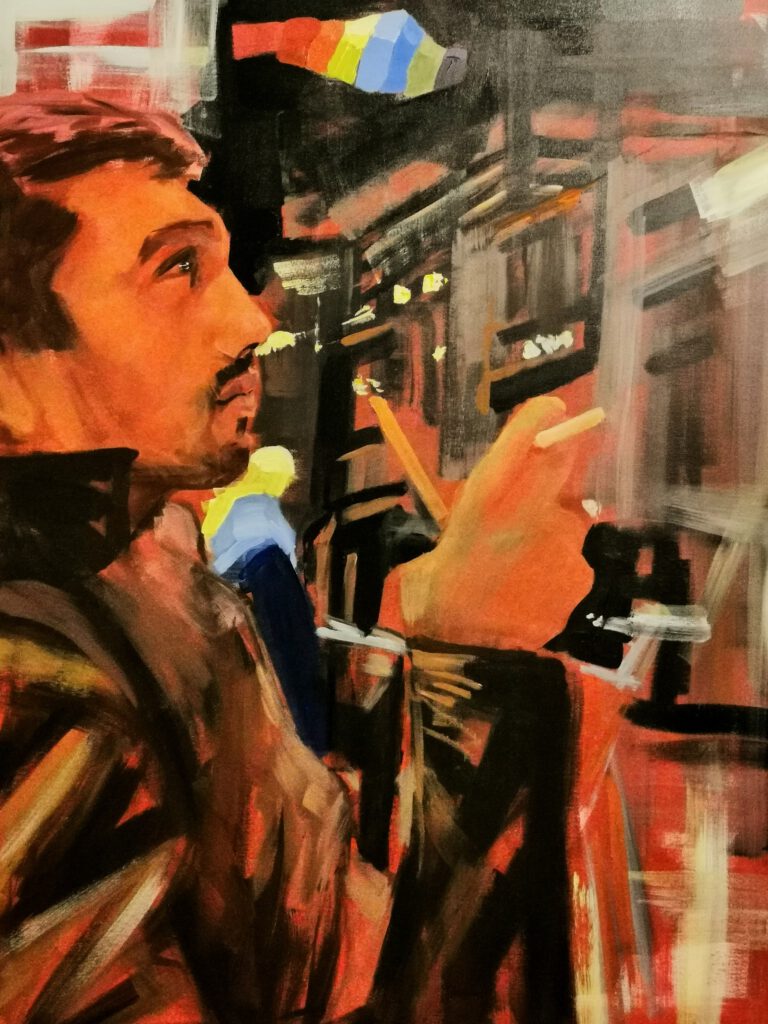
PRIDE EVENING
A rare Selman painting in which we see a public space behind a central figure. The linear composition consists of wide lines that appear on a sharp demarcation between two tonalities, with a body figure limited by lines and differences in light and a play of lines that mark space. Lines have different effects based on their location, direction, and purpose. Repetition of the same or similar elements and shapes, tones or colors in certain variants signifies a peculiar rhythm of the image. The atmosphere of one outing is in full swing. Not only is the painter introduced in the process of knowing or satisfying his curiosity, but above all the city tells its story. The rhythm is correct because the variations are the same. The smoke we don’t see above the cigarette in the night atmosphere might be interesting but Selman skillfully avoids it so as not to disturb the rhythm of the thought the view of the painted sends.
Selman did not aim to convey objective reality on the canvas, but to color his own feelings and convey the subjective view of reality on canvas so that something interesting happened to the actor at the Pride evening. What makes its actors special is their isolation and independence from the architectural or painting framework. The actor is placed in the frontal part of the space, rarely in an en face position, and the observer is often unable to recognize the astonishment that the character carries. The background of this image clearly merges and disappears merging with the figure itself, except for the colors of the rainbow, we do not see almost the same clear indication. With the absence of background and space, Selman wants the observer to feel the intimacy of that sincere and unique moment in which the actor experiences the culmination of thought.
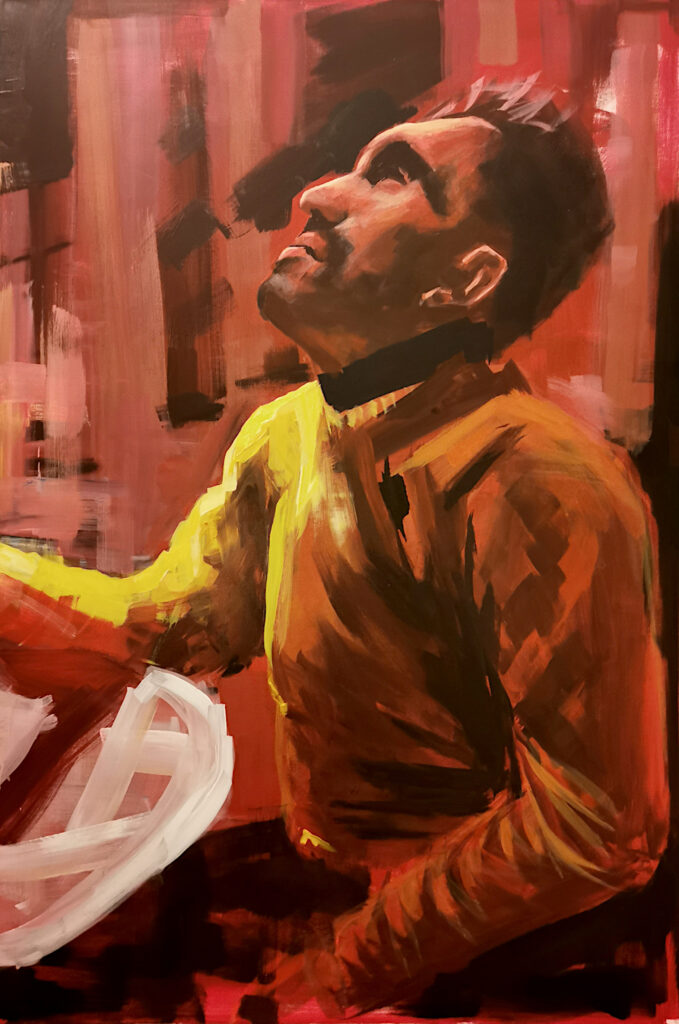
PRIDE EVENING II
Zanimljivost kod Selmanovih portreta je da uvijek ispuni dva osnovna zadatka: prikazom određene osobe je uvijek ukaže sa njenim fizičkim obilježjima i psihičkim izrazom. Svaki slikarov portret je začudan i prikazanim sadržajem rijetko pokaže samo čisto lice ili glavu, poprsje, obično ukaze na lik do koljena ili cijelu figuru. Portretima i autoportretima Selman ostaje vjeran. Odnos prema prikazu ljudskog lika kroz deceniju mijenja. Selmanovi portreti osim prikaza lica, više nego često izražavaju i narav portretirane osobe. Malo gdje naglašava odnos između umjetnika i portretiranog, ponekad su naglašeni detalji odjeće i scene, ali često ne.
Ono što se svakako treba uzeti u obzir na ovoj slici jeste da prostor/okruženje u kojem se figura nalazi je nužno bitno koliko važnost prepoznavanja intimnosti posebnog trenutka u danu kojeg akter poštuje. Kao ikona moleći se nebesima za blagodeti koje dobija. Nijansama žute stvara svjetlost koja se probija odozgo i štiti svoga aktera. Spas ili početak u jednom Pride večeru. Akter nam se niti direktno, niti indirektno obraća. Ukoliko se pažljivo pogleda većina Selmanovih nefrontalnih aktera na slikama, uoči se da figure često čak ignorišu posmatrača. Svi akteri su zaokupirani samima sobom, oni se ne obraćaju posmatraču, niti slikaru – oni su stidljivi, zamišljeni, zauzeti, rezervisani, zaboravljeni, nedokučivi, začudni, ali nikada arogantni. Selmanovi akteri su ponekad fizički netjelesni, ali duhovno napeti, teški, opterećeni emocijama, dok ponekad plošni, oskudni, gotovi prazni ili potpuno ispražnjeni.
PRIDE EVENING II
The interesting thing about Selman's portraits is that he always fulfills two basic tasks: by depicting a certain person, he always indicates it with his physical characteristics and mental expression. Each portrait of the painter is astonishing and the content shown rarely shows only a clean face or head, a bust, usually indications of a figure up to the knee or the whole figure. With portraits and self-portraits Selman remains faithful. The attitude towards the portrayal of the human figure has changed over the decades. Selman's portraits, in addition to depicting faces, more than often express the nature of the person portrayed. Few places emphasize the relationship between the artist and the portrayed, sometimes the details of the clothing and the scene are emphasized, but often not.
What should definitely be taken into account in this picture is that the space / environment in which the figure is located is necessarily as important as the importance of recognizing the intimacy of a particular moment in the day that the actor respects. As an icon, praying to heaven for the blessings he received. Shades of yellow create light that penetrates from above and protects its actor. Salvation or start in one Pride dinner. The actor addresses us neither directly nor indirectly. If you look closely at most of Selman's non-frontal actors in the pictures, you can see that the figures often even ignore the observer. All actors are preoccupied with themselves, they do not address the observer or the painter – they are shy, thoughtful, busy, reserved, forgotten, unfathomable, strange, but never arrogant. Selman’s actors are sometimes physically disembodied but spiritually tense, heavy, burdened with emotion, while sometimes flat, sparse, almost empty or completely emptied.
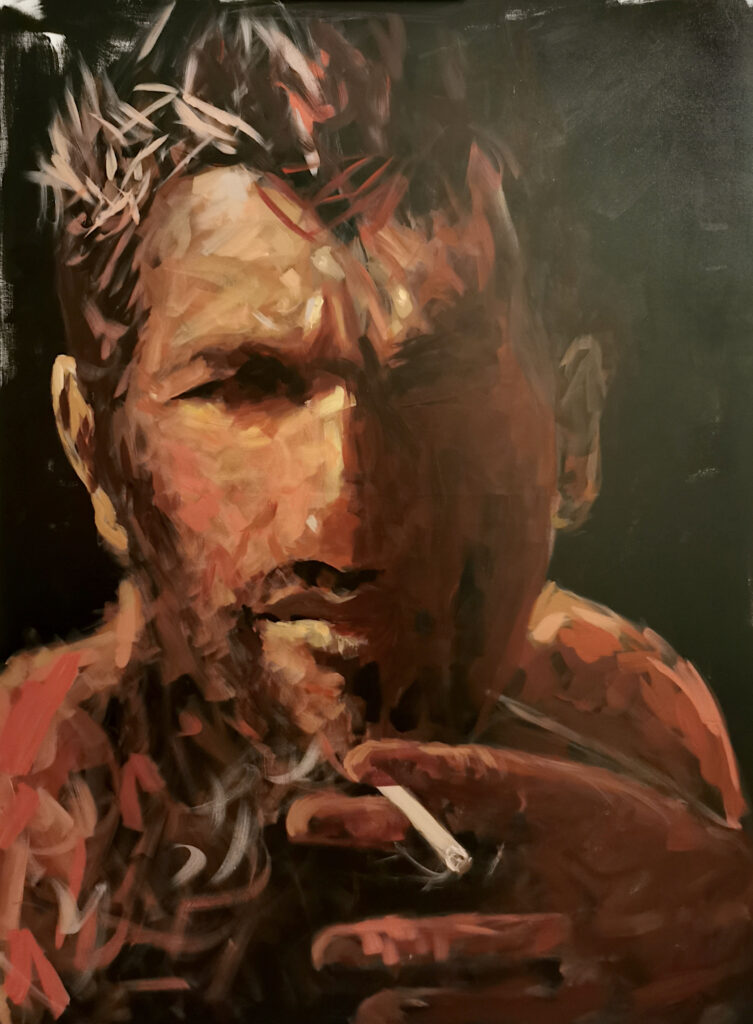
Dim
Jedna od temeljnih ljudskih potreba je potreba za smislom zbog kojeg je vrijedno živjeti. Nema onih pitanja: Zašto uopće ujutro ustajem? Ima li smisla to što radim? Šta mi se to događa? Kakvog smisla ima moj vlastiti život? Selmanov život se mnogo ne razlikuje od njegovih slika. To nije puka težnja. On živi život istinski, onako kako ga vidi i kako ga doživljava. Put je ljubavi koju daje onako usput i kome treba, i kome ne. Drugačije ne zna. Kao da je već odavno absolvirao koncept i kao da živi ikigai, japanski filozofski koncept o onome što život čini vrijednim življenja. Selman je odavno shvatio da zna šta voli da radi u životu, da želi samo da čini to što najbolje umije. Bez obzira na sve životne prepreke, kojih je slikar Selman imao bezbroj u svom životu, naučio se biti sretan zahvaljući konstantnom razvijanu svog slikarskog talenta, svojoj znatiželji, želji da putuje, da spoznaje, da upozna i druge kulture, želju za porodicom i da se budi pored nekoga koga neizmjerno voli, poštuje i razumije se s njim.
Dim je autoportret koji se jednotsvano može nazvati i Merso ili Buđenje ili Ogledalo ili Prva cigareta. Ovo je ostvarena vlastita zrcalna slika. Obično su Selmanovi autoportreti slikani ili crtani u polovičnoj figuri, dok su prikazi čitavog lika mnogo rjeđi. (Iako nisu mnogobrojni , takvi autoportreti su zanimljivi, upravo svojom strukturom i kompozicijom, posebno oni ležeći sa en face stopalima.) Selman ne poznaje jednoličnost, ne kopira realni odraz – uočavamo opet više čas, vrijeme i kompletnu atmosferu jednog momenta nakon buđenja, impersija je jaka, nisu su mu bitne jasne konture lica figuranta. Većina njegovih autoportreta prelazi u umjetničkom pogledu razinu zanimljivog i inspirativnog djela. (Kažem većina jer slike koje radi za narudžbu preko porodičnih fotografija nisu uvijek u Selmanovskom duhu, tu se slikar dodvorava kupcu i njegovom ukusu.) Iako svoje trenutke bilježi mobitelskim fotoaparatom (što je sigurno slučaj i sa Dimom), te na osnovu takvih neprofesionalnih fotografija stvara autoportrete ili portrete, slikama ipak odiše oduhovljenost materijalnog odraza, vidi se neobičnost majstorskog svladavanja likovne materije, jednostavnost Selmanog poteza kistom i sloboda korištenja i miješanja boja.
Smoke
One of the fundamental human needs is the need for meaning that makes it worth living. None of those questions: Why do I get up in the morning at all? Does what I do make sense? What's happening to me? What is the meaning of my own life? Selman's life is not much different from his paintings. This is not a mere aspiration. He lives life truly, as he sees it and as he experiences it. It is a path of love that he gives along the way, both to whom he needs and to whom he does not. He doesn't know any other way. It’s as if he’s long ago mastered the concept and as if he’s living ikigai, a Japanese philosophical concept about what makes life worth living. Selman realized long ago that he knows what he likes to do in life, that he just wants to do what he does best. Despite all the obstacles in life, which the painter Selman had countless in his life, he learned to be happy thanks to the constant development of his painting talent, his curiosity, desire to travel, to know, to meet other cultures, desire for family and to be next to someone you love, respect, and get along with immensely.
Smoke is a self-portrait that can also be called Merso or Awakening or Mirror or First Cigarette. This is my own mirror image. Usually, Selman's self-portraits are painted or drawn in half figure, while depictions of the whole character are much rarer. (Although not numerous, such self-portraits are interesting, precisely because of their structure and composition, especially those lying with en face feet.) Selman does not know uniformity, does not copy the real reflection – we notice again more hour, time and complete atmosphere of one moment after waking up, empire is strong, he does not care about the clear contours of the face of the defendant. Most of his self-portraits go beyond the level of an interesting and inspiring work in artistic terms. (I say most because the pictures he makes to order through family photos are not always in Selman's spirit, here the painter flatters the customer and his taste.) Although he captures his moments with a mobile camera (which is certainly the case with Dima), and on the basis of such unprofessional photos he creates self-portraits or portraits, the paintings still exude the spirituality of material reflection, you can see the unusualness of mastering the art, the simplicity of Selman's brushstroke and the freedom to use and mix colors.
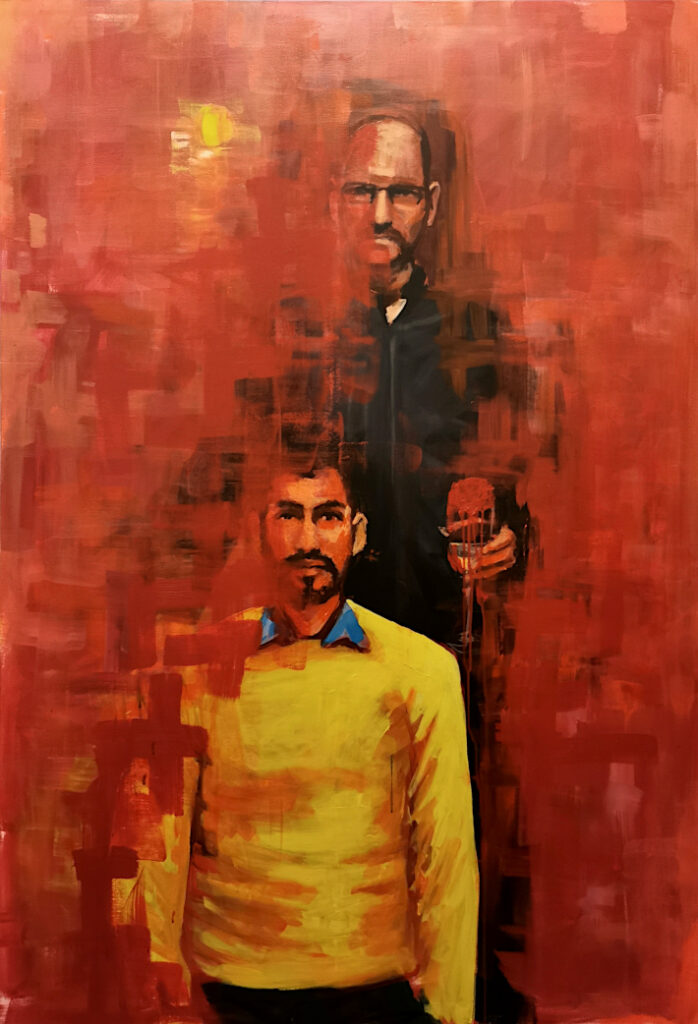
LUČA
Kada se ljudi zaljube, između njihovih srca se mogu vidjeti prelijepi lukovi ružičaste svjetlosti, a normalnim zlatnim pulsacijama u hipofizi pridodana je predivna ružičasta boja. Ravnopravnost je ključ uspjeha emotivnih veza čuvara. Čuvari vjeruju u ljubav, ali se je ne drže grčevito u strahu da će im pobjeći. Ako predugo ne dobivaju ono što zaslužuju, odlaze. Shvaćaju da je potrebno više pokušaja da bi se pronašao emocionalni i intelektualni istomišljenik.
Teško da će Selmanovi portreti i autoportreti mirovati. Na Luči ipak uspijevaju. Da li zbog svjetlosti koja kao anđeo čuvar treperi i poukazuje na ispravan put mada u okovansti crvenog platna ili tijelima dugih figurina ili anđeom čuvarom sa čašom u ruci, ili zbog žutog toplog džempera ili jednostavno zbog unutrašnjeg smiraja koji izbija iz zadovoljstva duša koje zrače. Svog arkanđela sa berlinskog neba Selman oblači u kontrastno ruho svećeničkog tipa (mada se može pričati i o drugom kolorističkom kontrastu), gdje crna boja u centralnom dijelu slike kao veliki ekser je čvrsto drži na zidu. Čak i bijeli svećenički okolovratnik se nazire. Da, autoportretista je na sigurnom, smiren, bez straha, kao petogodišnji dječačić raznježenog lica stoji i nakon izvršenog
zadatka. Da, pokornost i zahvalnost. Radost. Opet refleksija, opet špiglo, opet introspekcija ili igra
diplopijom ili dvoslikom, gdje se ne radi o pogreški perceptora nego o Selamnovoj igri, gdje se figure ne kopiraju nego izranjaju i pretapaju se jedna u drugu i druga iz jedne. Autoportretist ne kida, ne uzima, ne krade, niti dodiruju svjetlo. Ono se mu samo pruža, ispunjuje ga, širi se u njemu jer je oduvijek i bila dio njegove polovice, dio umjetničkog izražaja.
LIGHT
When people fall in love, beautiful bows of pink light can be seen between their hearts, and a beautiful pink color is added to the normal golden pulsations in the pituitary gland. Equality is the key to the success of guardian emotional ties. The guards believe in love, but do not hold on to it convulsively in fear that it will escape them. If they don’t get what they deserve for too long, they leave. They realize that it takes more effort to find an emotional and intellectual like-minded person. Selman's portraits and self-portraits are unlikely to stand still. At Luča, however, they succeed. Whether because of the light that flickers like a guardian angel and points to the right path, albeit in the shackles of a red cloth or the bodies of long figurines, or because of a guardian angel with a glass in his hand, or because of a yellow warm sweater or simply because Selman dresses his archangel from the Berlin sky in a contrasting priest-type attire (although one can talk about another coloristic contrast), where the black color in the central part of the painting, like a large nail, holds it firmly to the wall. Even the white priest's collar is in sight. Yes, the self-portraitist is safe, calm, without fear, like a five-year-old boy with a tender face, he still stands after task. Yes, obedience and gratitude. Joy. Again reflection, again spiegel, again introspection or play diplopia or double vision, where it is not a mistake of the perceptor but of Selam's play, where the figures are not copied but emerged and merged into one another and the other from one. The self-portraitist does not tear, take, steal, or touch the light. It just extends to him, fills him, expands in him because it has always been a part of his half, a part of artistic expression.

